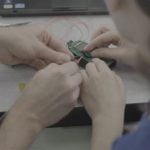.jpg)
Imagine you’re visiting a new city for the first time. As you explore the main tourism district, your phone sends you an alert. It’s a tweet from your smartphone, suggesting a nearby restaurant that you might enjoy. The recommendation is based not only on your location, but also on your previous social activity – all those posts about tapas were run through an algorithm that allowed your phone to alert you when you were near an amazing tapas restaurant.
Or perhaps you are at home, and you need a reminder to switch the laundry from the washer into the dryer as soon as it’s ready. You set your machine and then ask for it to send you a text when it’s time. And since nothing these days happens unless it’s recorded on social media, your machine can even send out a tweet or update your Facebook status to let the world know that your whites are done.
With the Internet of Things (IoT) seemingly taking over almost every facet of our lives, these scenarios may not be all that far off. Nearly everything in our lives, from appliances to vehicles to even clothing, is now being designed with some type of embedded Wi-Fi connectivity. This connectivity is not only changing how we live, work, and play, but it’s also changing how we relate to each other and what it means to be social. In fact, the IoT is actually changing the very nature of social media itself.
Contents
Why Social IoT Matters
Over the last decade, social media has already changed what it means to be social. “Friend” has become a verb, and most of us interact with people online more than we do in-person. Whether it’s via Facebook, Twitter, Instagram, Pinterest, Snapchat, or another platform, social media has simultaneously made the world bigger and smaller. While there is some overlap among social sites, for the most part, data is largely siloed and kept separate. In other words, there is little sharing of data and information across platforms or interconnectivity among them, thereby limiting the potential of a truly social IoT.
All of that is changing, though. With so many of the things that we use every day now connected to the internet in some fashion, it’s only logical to presume that social media is going to want to get in on the action in some way. Not only does connecting our devices to social platforms drive our attention to those platforms – especially when we can control devices using a tweet or status update, using the social services as a sort of control panel for our lives – but the data that can potentially be mined from such social connections. Companies can use the data collected via social platforms to learn more about their customers’ preferences, habits, interactions, and more, and then use that data for a better understanding of customer behavior – and more targeted marketing.
Changing the Meaning of Social
The IoT will change more than just the way companies use data collected via social media. It may actually change the way we interact with each other as well, changing the very meaning of what it is to be social.
One area that is gaining a lot of attention within this realm is the notion of privacy, or more specifically, the definition of privacy. While some argue that privacy is “dead,” and anything that promises privacy is an illusion, others argue that the IoT is simply going to change the definition of privacy. Decisions about what to share with whom and where will become more nuanced, and the expectation of complete privacy is bound to become somewhat untenable as devices are developed with the ability to share reams of information, no matter how seemingly insignificant it may appear.
The social IoT is also likely to change our definitions of community – and how we interact within each community. We already see context-dependent communities in social media, as individuals join groups or interact using specific hashtags. However, as everything becomes more connected, additional communities will develop as a way to develop a more meaningful experience as individuals interact with each other based on a shared connection.
The social IoT is going to do more than simply allow us to live better or manage our lives more easily with the few taps of a touchscreen. With everything becoming more connected every day, the very nature of our social interactions is going to change – as will the way that social media integrates into our lives.
[Source:- Socialmediatoday]b










